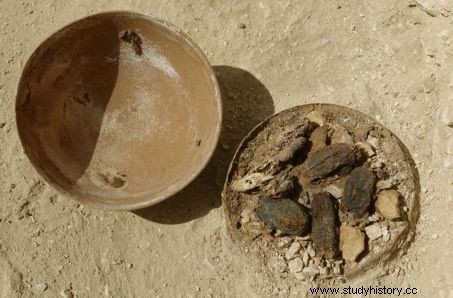A team of Spanish archaeologists has unearthed the remains of a burial garden in the necropolis of Abu El Naga Draa in Egypt.

A 4000-year-old ancient burial garden discovered near Luxor, ancient Thebes (Egypt).
Plants, flowers and fruit trees accompanied the ancient Egyptians on their final journey to the afterlife as depicted in depictions and wall paintings (see below ). For the first time, Spanish researchers have just discovered one of these funerary gardens in the necropolis of Abu el Naga Draa, near Luxor, ancient Thebes, in Egypt. “Never has such a burial garden been unearthed », Enthuses José Manuel Galan, the mission director of the Djehuty project, started in 2002.

Representation of a funerary garden, with its small quadrilaterals. © Csic
Dated to around 3900 years old, the miniature orchard stood at the entrance to a tomb from the Middle Kingdom (2040-1782 BC). 3m by 2m wide, plants and flowers were grown in compartments of about 30 centimeters on each side. Thin layers of silt have been found in these small quadrilaterals, as well as remains of roots preserved for almost 4000 years. Sycamores and palm trees were often featured in the wall frescoes, will Spanish researchers find traces of them among the exposed roots? “We do indeed know that palm, sycamore or Persea -a plant of the avocado family-, were associated with the resurrection, or that plants such as lettuce were linked to fertility, and therefore life. We must now wait for the results of the ongoing identifications explained the researcher.

Virtual reconstruction of the funeral garden of Abou el Naga Draa, near Luxor. © Csic
Small ceramic containers were also found, bordering the moving vestige. At least four dates and some fruits under study were kept there, no doubt produced by this garden as offerings.

Remains of date and seed offerings found preserved in ceramics for 4000 years. © Cisc
"These cultivated gardens had a symbolic meaning, which will provide information on religious beliefs and practices, as well as on the culture of the society of the time, when Thebes, had become the first capital of the unified kingdom of Upper and Lower Egypt", adds José Manuel Galan, of the Superior Council of Spanish Scientific Research (CSIC). A rare and precious testimony to these plant landscapes of the beyond, symbol of the cycle of life and resurrection so dear to the ancient Egyptians.
For centuries, the inhabitants of the Nile have also adorned the interior of the tombs with garlands of celery flowers, chamomile, fruit, poppies and dandelions, just as they decorated the mummies, but also the sarcophagi of the pharaohs and illustrious personages. Up to onion scales sometimes placed on the eyelids, or placed between the toes. Under the bandages of Ramses II, archaeologists have found whole water lily flowers, other times it was cornflowers, which are said to have been brought from Syria by Thutmose around 1500 BCE, the one whom was called the gardener Pharaoh. Among the spoils of war from his military campaigns, he liked to bring back plants, to see whole trees as certain bas-reliefs show. Thutmose who also had in his tomb the remains of a veritable botanical garden! (read Science and the Future n°802 ).
According to the Spanish researcher, a small brick chapel at the entrance to the tomb contained three stelae posterior to the burial and the garden. Dating back to the XII th dynasty (around 1800 BC), one bore the name of a certain Renef-seneb, another that of a certain Khememi "the son of the lady of the house, Satidenu", in addition of the god of ancient Thebes, Montu, as well as the funerary deities Ptah, Sokar and Osiris.
